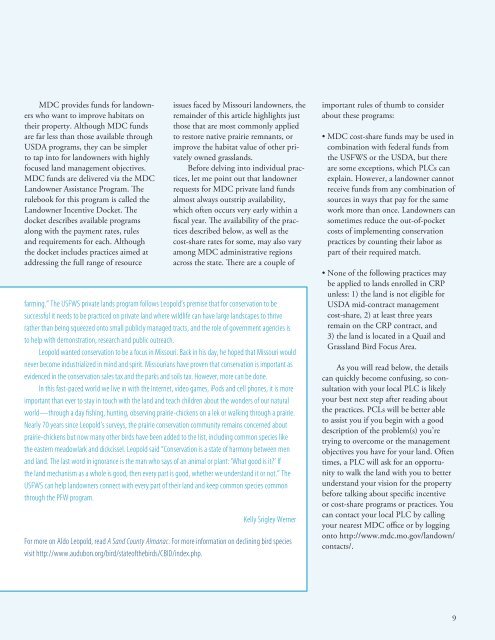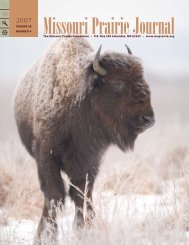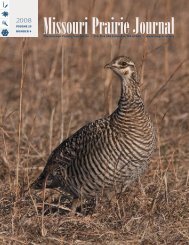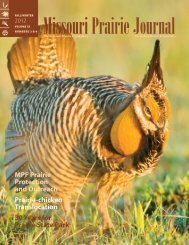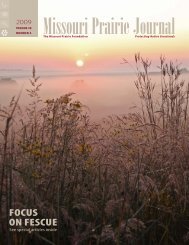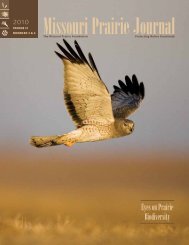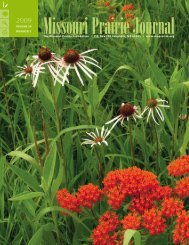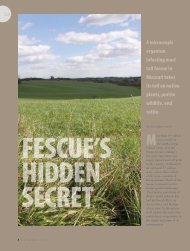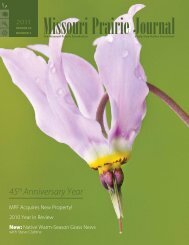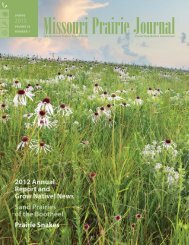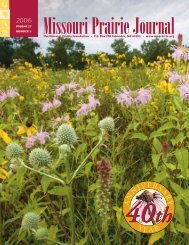Summer 2007: Volume 28, Number 3 - Missouri Prairie Foundation
Summer 2007: Volume 28, Number 3 - Missouri Prairie Foundation
Summer 2007: Volume 28, Number 3 - Missouri Prairie Foundation
- No tags were found...
Create successful ePaper yourself
Turn your PDF publications into a flip-book with our unique Google optimized e-Paper software.
MDC provides funds for landownerswho want to improve habitats ontheir property. Although MDC fundsare far less than those available throughUSDA programs, they can be simplerto tap into for landowners with highlyfocused land management objectives.MDC funds are delivered via the MDCLandowner Assistance Program. Therulebook for this program is called theLandowner Incentive Docket. Thedocket describes available programsalong with the payment rates, rulesand requirements for each. Althoughthe docket includes practices aimed ataddressing the full range of resourceissues faced by <strong>Missouri</strong> landowners, theremainder of this article highlights justthose that are most commonly appliedto restore native prairie remnants, orimprove the habitat value of other privatelyowned grasslands.Before delving into individual practices,let me point out that landownerrequests for MDC private land fundsalmost always outstrip availability,which often occurs very early within afiscal year. The availability of the practicesdescribed below, as well as thecost-share rates for some, may also varyamong MDC administrative regionsacross the state. There are a couple offarming.” The USFWS private lands program follows Leopold’s premise that for conservation to besuccessful it needs to be practiced on private land where wildlife can have large landscapes to thriverather than being squeezed onto small publicly managed tracts, and the role of government agencies isto help with demonstration, research and public outreach.Leopold wanted conservation to be a focus in <strong>Missouri</strong>. Back in his day, he hoped that <strong>Missouri</strong> wouldnever become industrialized in mind and spirit. <strong>Missouri</strong>ans have proven that conservation is important asevidenced in the conservation sales tax and the parks and soils tax. However, more can be done.In this fast-paced world we live in with the Internet, video games, iPods and cell phones, it is moreimportant than ever to stay in touch with the land and teach children about the wonders of our naturalworld—through a day fishing, hunting, observing prairie-chickens on a lek or walking through a prairie.Nearly 70 years since Leopold’s surveys, the prairie conservation community remains concerned aboutprairie-chickens but now many other birds have been added to the list, including common species likethe eastern meadowlark and dickcissel. Leopold said “Conservation is a state of harmony between menand land. The last word in ignorance is the man who says of an animal or plant: ‘What good is it?’ Ifthe land mechanism as a whole is good, then every part is good, whether we understand it or not.” TheUSFWS can help landowners connect with every part of their land and keep common species commonthrough the PFW program.Kelly Srigley WernerFor more on Aldo Leopold, read A Sand County Almanac. For more information on declining bird speciesvisit http://www.audubon.org/bird/stateofthebirds/CBID/index.php.important rules of thumb to considerabout these programs:• MDC cost-share funds may be used incombination with federal funds fromthe USFWS or the USDA, but thereare some exceptions, which PLCs canexplain. However, a landowner cannotreceive funds from any combination ofsources in ways that pay for the samework more than once. Landowners cansometimes reduce the out-of-pocketcosts of implementing conservationpractices by counting their labor aspart of their required match.• None of the following practices maybe applied to lands enrolled in CRPunless: 1) the land is not eligible forUSDA mid-contract managementcost-share, 2) at least three yearsremain on the CRP contract, and3) the land is located in a Quail andGrassland Bird Focus Area.As you will read below, the detailscan quickly become confusing, so consultationwith your local PLC is likelyyour best next step after reading aboutthe practices. PCLs will be better ableto assist you if you begin with a gooddescription of the problem(s) you’retrying to overcome or the managementobjectives you have for your land. Oftentimes, a PLC will ask for an opportunityto walk the land with you to betterunderstand your vision for the propertybefore talking about specific incentiveor cost-share programs or practices. Youcan contact your local PLC by callingyour nearest MDC office or by loggingonto http://www.mdc.mo.gov/landown/contacts/.


